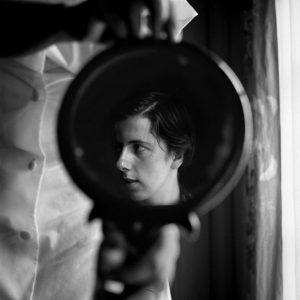

From its blooper-like beginning, the documentary “Finding Vivian Maier” begs you not to take it seriously, which is strange given the ardent effort by director John Maloof to literally develop the work of his eponymous subject. At the movie's cutesy onset, we're teased by the eye rolls and smirks of yet-to-be-identified interviewees. They cryptically scoff about the hypothetical reactions of a mysterious character we soon learn is Vivian Maier. One older woman, who kind of looks like a frosty-hair version of Liza Minnelli, tops off the gossipy introduction by saying, “She would have never let this happen”---- “this” referring to Maloof's exposé of the now deceased French-American artist that only half-heartedly questions whether or not it's an invasion of that artist's extreme privacy.
Maier was born in 1926. For most of her adult life, she subsisted as a nanny for New York City and Chicago families before entering a social and economic desolation in her later years. During Maier's career, the hoarder also snuck hundreds of thousands of choice street-photographs with her chest-level camera, almost all of which remained canned negatives until falling into the hands of Maloof. Believing in their brilliance, the ambitious media-savant displayed Maier's photographs online and eventually snagged a gallery opening at Chicago's History Museum, making Maier an instant-hit among viewers.
As an inspection of Maier's startling photography, “Finding Vivian Maier” is hardly adequate. For the most part, her black and white photographs are shown in quick montages worthy of an iPhone commercial and are usually backed by various people telling us what to think about them. Some of the commentary is great, more of it is repetitive. But as a peek at who Maier was as a person, the documentary is much stronger---mostly thanks to the supple emotional beats of various interviewees. The families Maier used to work for are particularly affecting. One wife and mother, who at first seems oddly unreadable and then becomes intelligent and wistful, recalls the sorrow of having to let Maier go after her unstable behavior got out of hand. Another daughter discloses a brutal side of Maier, remembering how Maier use to viciously hold her down and force-feed her meals everyday. The mixture of horror and sympathy that arise out of these memories are what haunt the beauty and confidence of Maier's photographs.
Maloof and co-writer and director, Charlie Siskel, seem too busy sensationalizing the story to recognize this tension thoughtfully, though. Where hesitance could flower, a push to globally extol Maier and the fluke discovery of her work takes over. “Vivian had no lightness and sweetness to her” says that wife and mother who knew when it was time to part ways with Maier, yet Maloof, zooming in on Maier as much as possible, went on to make a documentary that is mostly sweet and light. Worst of all might be J. Ralph's score, which bright, plucking, and triumphant, starts off as a trite annoyance and becomes a clobbering assault.